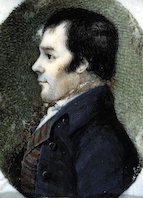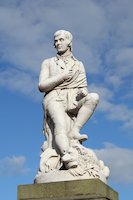Robert Burns
All about Robert Burns

This Burns Night, find out more about one of Scotland’s most famous sons.
Key dates
- 25th January 1759—Robert Burns born and Alloway, Ayr
- 1765—James Murdoch becomes tutor to Robert.
- 1784—Burns moves to Machline
- 1785—Marries Jean Armour
- July 1786—Published his first book of poems.
- May 1787—Set off on a tour of Scotland and Edinburgh edition of works published
- 1788—Moves to farm at Ellisland
- September 1789—Moves to Dumfries and begins work for the Excise in Dumfries-shire
- 21 July 1796—Died in Dumfries at 37
Key facts
- Widely regarded as the National Poet of Scotland, known as The Bard (in Scotland), The Ploughman Poet or the Bard of Ayrshire.
- Mainly home educated, he began working life as a farm labourer at Mount Oliphant Farm, Alloway.
- Poems, chiefly in a Scottish dialect, his first book of poems known as the Kilmarnock edition, cost 3 shillings and sold out within a month.
- His second edition of poems, The Edinburgh edition, published in 1787.
- The first volume of The Scots Musical Museum was published. This was done in collaboration with a music-seller, James Johnson, and was a collection of Scottish folk songs.

Publications
Poems, chiefly in the Scottish dialect
The first collection of Burns’s work to appear in print. Published in Kilmarnock by John Wilson in 1786, known as ‘The Kilmarnock edition’. It includes the poems To a Mouse and To a Louse.
The Calf
Published in 1797, it was written in order to win a bet with Gavin Hamilton that he ‘would not produce a poem on the subject in a given time’.
The Scots Musical Museum, by James Johnson
Although produced by Johnson, Burns was editor and principal contributor. Includes Auld Lang Syne. Published in Edinburgh by N Stewart, 1787-1803.
Scholastic resources
- Author profile
- Work sheets
- Address to Edinburghposter, glossary activity and teachers’ notes
- See all resources
Events
- Burns an’ a’ that Festival: 16th-24th May
- Homecoming Scotland: a year-long programme of events celebrating Scotland’s contributions to the world.
Links
Published 19 January 2009